Data Insights for Business Decisions: ASDA Group Plc Analysis Report
VerifiedAdded on 2023/06/10
|11
|1142
|470
Report
AI Summary
This report analyzes data insights for business decisions within ASDA Group Plc, focusing on data collection, storage, and strategic utilization. It differentiates between orthodox market research and Big Data, explaining how information is captured and stored using databases and management information systems. The report also examines the impact of technological advancements on data use in decision-making and highlights the strategic importance of data in ASDA's daily operations. Furthermore, it outlines potential research avenues for improving data capture and use within the organization, emphasizing the critical role of data analysis in gaining a competitive advantage. Desklib provides a platform to explore similar solved assignments and past papers.

DATA INSIGHTS FOR BUSINESS
DECISIONS
DECISIONS
Paraphrase This Document
Need a fresh take? Get an instant paraphrase of this document with our AI Paraphraser
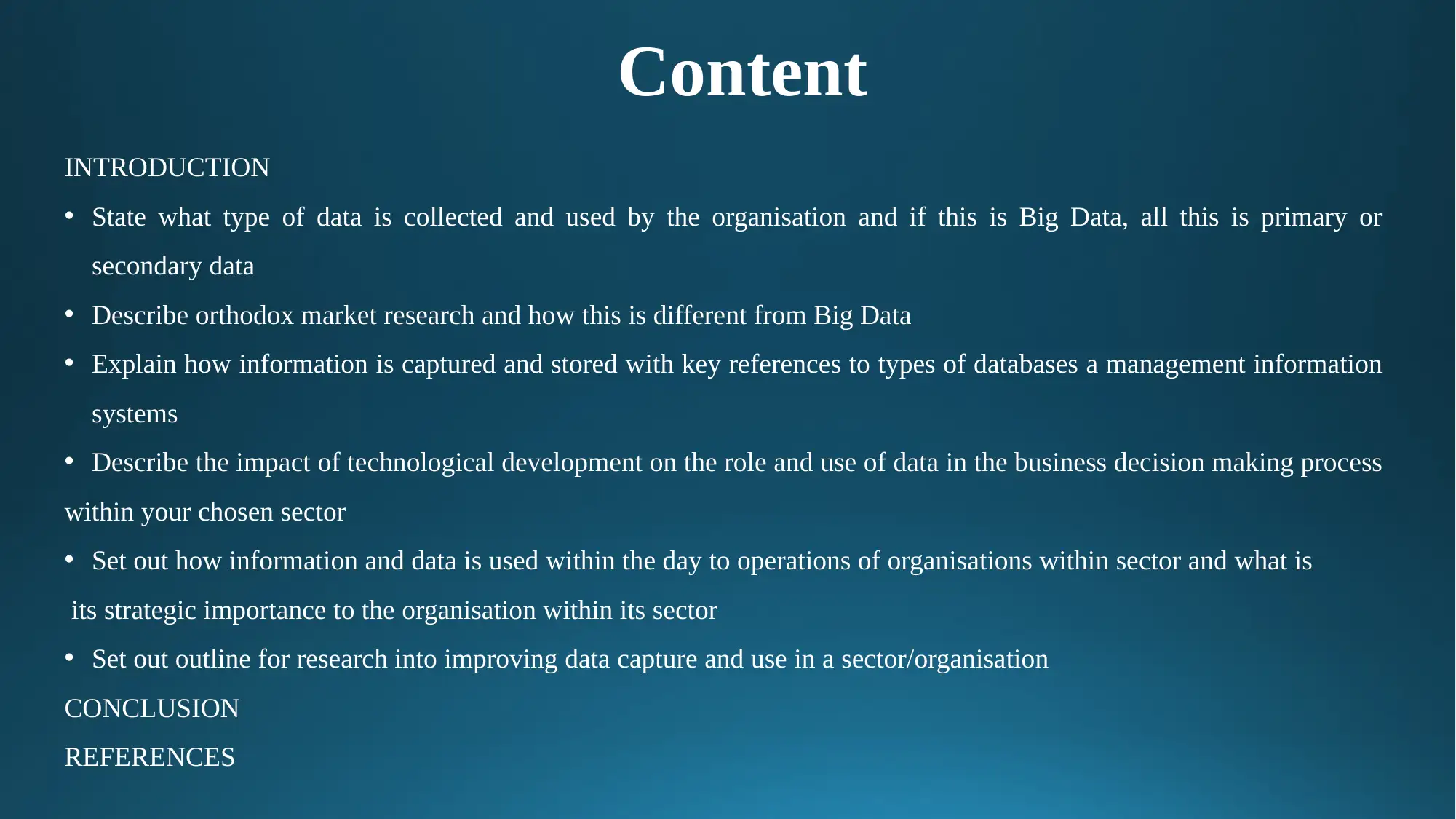
Content
INTRODUCTION
• State what type of data is collected and used by the organisation and if this is Big Data, all this is primary or
secondary data
• Describe orthodox market research and how this is different from Big Data
• Explain how information is captured and stored with key references to types of databases a management information
systems
• Describe the impact of technological development on the role and use of data in the business decision making process
within your chosen sector
• Set out how information and data is used within the day to operations of organisations within sector and what is
its strategic importance to the organisation within its sector
• Set out outline for research into improving data capture and use in a sector/organisation
CONCLUSION
REFERENCES
INTRODUCTION
• State what type of data is collected and used by the organisation and if this is Big Data, all this is primary or
secondary data
• Describe orthodox market research and how this is different from Big Data
• Explain how information is captured and stored with key references to types of databases a management information
systems
• Describe the impact of technological development on the role and use of data in the business decision making process
within your chosen sector
• Set out how information and data is used within the day to operations of organisations within sector and what is
its strategic importance to the organisation within its sector
• Set out outline for research into improving data capture and use in a sector/organisation
CONCLUSION
REFERENCES

INTRODUCTION
The outcome of a company's examination of an information source
relevant to a certain issue or circumstance is analytical insights. Data
analytics provides information which enable firms make more
knowledgeable selections whilst still decreasing the threat of
conventional trial-and-error assessment techniques. The paper
successfully addresses many elements of advanced analytics, such as
information collecting, utilisation, exploration, and so forth, in the
setting of ASDA Groups Plc that seems to be the largest commercial
grocery network in the United Kingdom and conducts trade
internationally.
The outcome of a company's examination of an information source
relevant to a certain issue or circumstance is analytical insights. Data
analytics provides information which enable firms make more
knowledgeable selections whilst still decreasing the threat of
conventional trial-and-error assessment techniques. The paper
successfully addresses many elements of advanced analytics, such as
information collecting, utilisation, exploration, and so forth, in the
setting of ASDA Groups Plc that seems to be the largest commercial
grocery network in the United Kingdom and conducts trade
internationally.
⊘ This is a preview!⊘
Do you want full access?
Subscribe today to unlock all pages.

Trusted by 1+ million students worldwide

State what type of data is collected and used by the
organisation and if this is Big Data, all this is primary or
secondary data
Information is among the most valuable tools
accessible to today's organisations. If businesses have much
more information regarding their clients, they could fully
understand their preferences, expectations, and desires. There
are two sorts of data: primary data and secondary data. The
below is a summary of significant information collected by
ASDA:
• Primary Data
• Secondary Data-
organisation and if this is Big Data, all this is primary or
secondary data
Information is among the most valuable tools
accessible to today's organisations. If businesses have much
more information regarding their clients, they could fully
understand their preferences, expectations, and desires. There
are two sorts of data: primary data and secondary data. The
below is a summary of significant information collected by
ASDA:
• Primary Data
• Secondary Data-
Paraphrase This Document
Need a fresh take? Get an instant paraphrase of this document with our AI Paraphraser
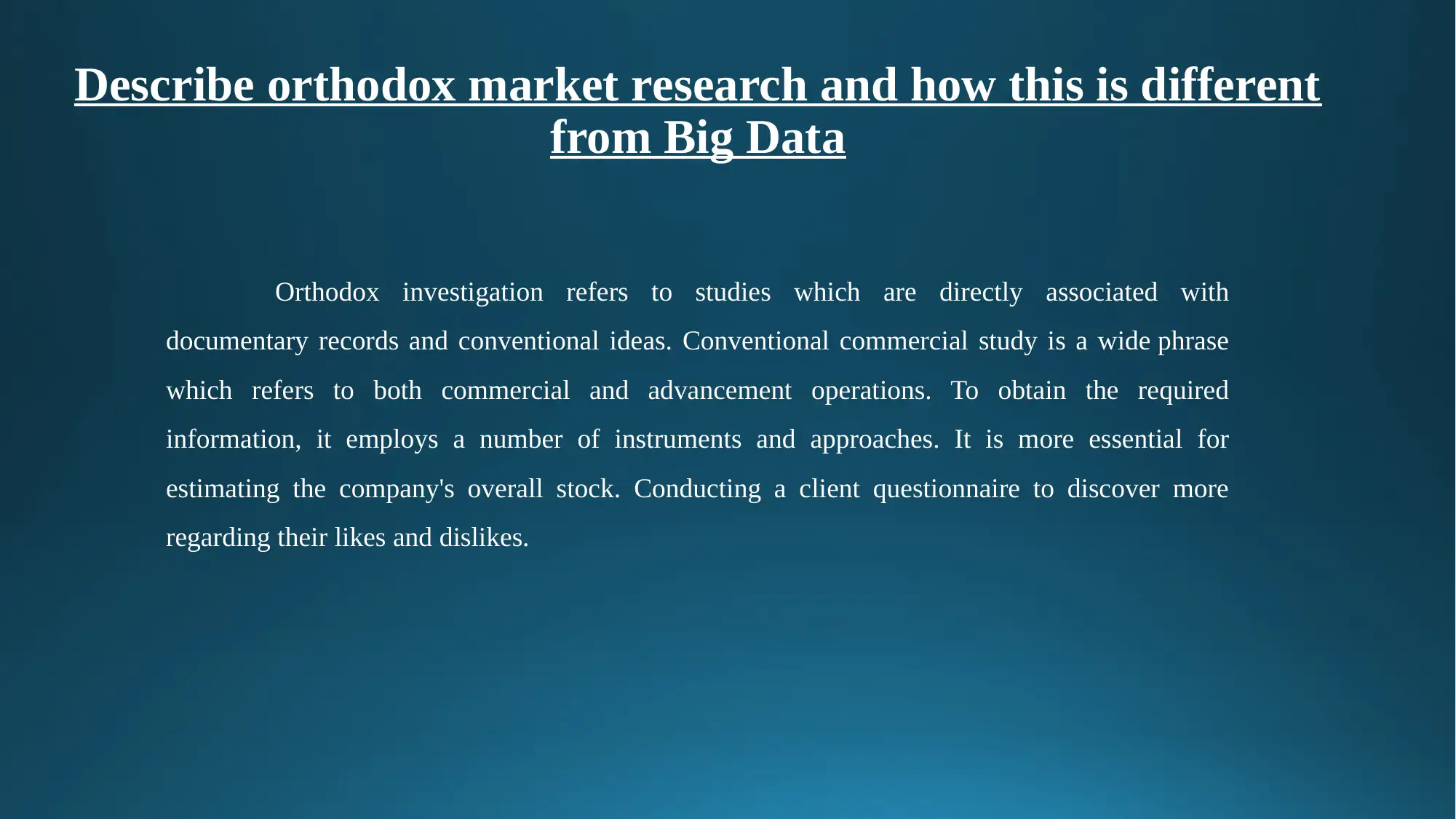
Describe orthodox market research and how this is different
from Big Data
Orthodox investigation refers to studies which are directly associated with
documentary records and conventional ideas. Conventional commercial study is a wide phrase
which refers to both commercial and advancement operations. To obtain the required
information, it employs a number of instruments and approaches. It is more essential for
estimating the company's overall stock. Conducting a client questionnaire to discover more
regarding their likes and dislikes.
from Big Data
Orthodox investigation refers to studies which are directly associated with
documentary records and conventional ideas. Conventional commercial study is a wide phrase
which refers to both commercial and advancement operations. To obtain the required
information, it employs a number of instruments and approaches. It is more essential for
estimating the company's overall stock. Conducting a client questionnaire to discover more
regarding their likes and dislikes.
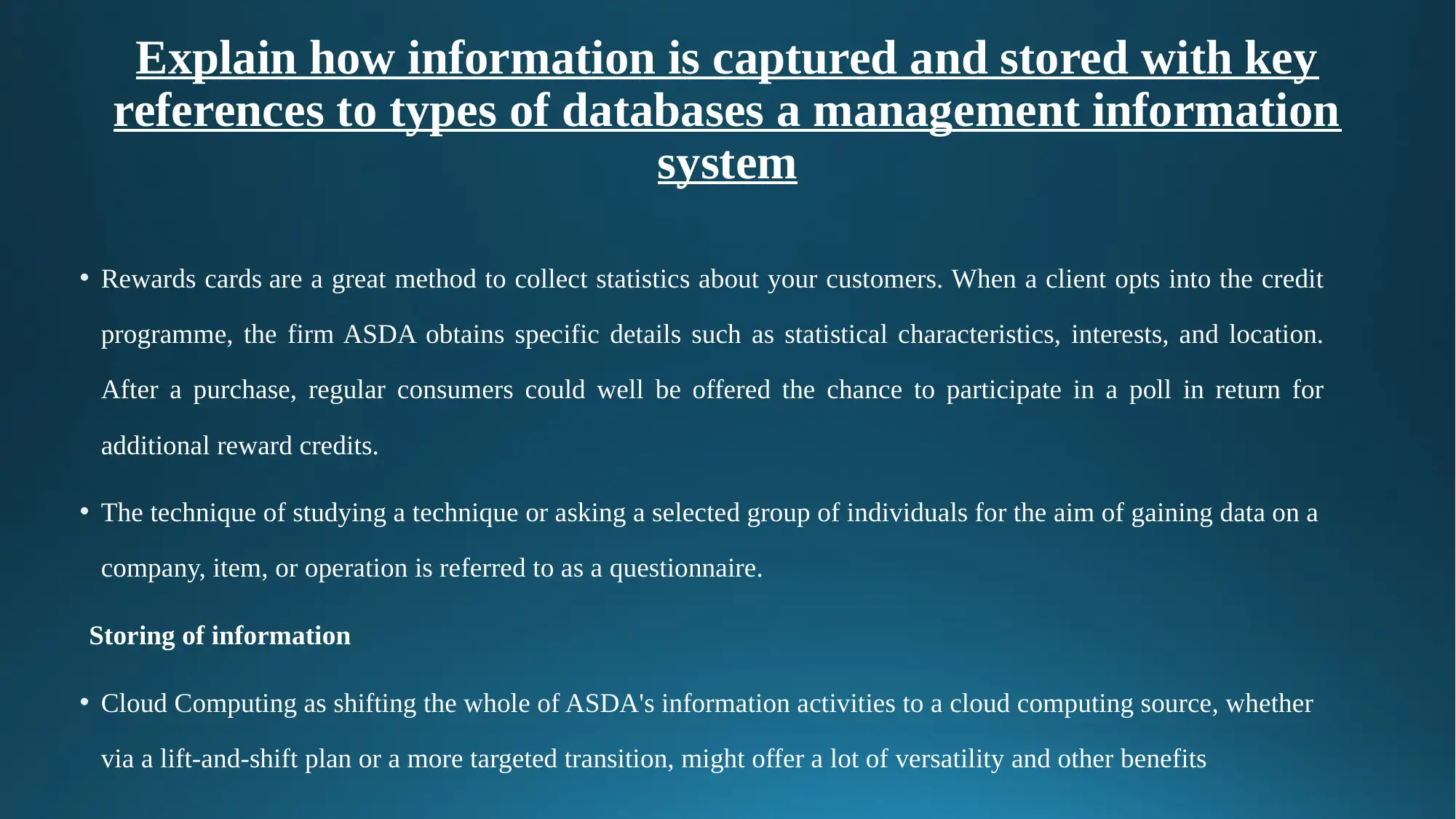
Explain how information is captured and stored with key
references to types of databases a management information
system
• Rewards cards are a great method to collect statistics about your customers. When a client opts into the credit
programme, the firm ASDA obtains specific details such as statistical characteristics, interests, and location.
After a purchase, regular consumers could well be offered the chance to participate in a poll in return for
additional reward credits.
• The technique of studying a technique or asking a selected group of individuals for the aim of gaining data on a
company, item, or operation is referred to as a questionnaire.
Storing of information
• Cloud Computing as shifting the whole of ASDA's information activities to a cloud computing source, whether
via a lift-and-shift plan or a more targeted transition, might offer a lot of versatility and other benefits
references to types of databases a management information
system
• Rewards cards are a great method to collect statistics about your customers. When a client opts into the credit
programme, the firm ASDA obtains specific details such as statistical characteristics, interests, and location.
After a purchase, regular consumers could well be offered the chance to participate in a poll in return for
additional reward credits.
• The technique of studying a technique or asking a selected group of individuals for the aim of gaining data on a
company, item, or operation is referred to as a questionnaire.
Storing of information
• Cloud Computing as shifting the whole of ASDA's information activities to a cloud computing source, whether
via a lift-and-shift plan or a more targeted transition, might offer a lot of versatility and other benefits
⊘ This is a preview!⊘
Do you want full access?
Subscribe today to unlock all pages.

Trusted by 1+ million students worldwide

Set out how information and data is used within the day to
operations of organisations within sector and what is its
strategic importance to the organisation within its sector
• Advertising and promotion are efforts which urge clients to acquire things. From digital commercials to
internet surveys, information is valuable to each stage of marketing and promoting.
• Item engagement includes the operations that a corporation performs after an item has already been
purchased in order to maintain and improve the supplier's functionality.
• Supply chain is operations that are conducted to supply merchandise and other necessary components.
• Logistics refers to any part of a corporation which is responsible for providing completed products
accessible to ASDA's many stores.
• Distribution strategy as these are all the positions required to get goods to clients.
operations of organisations within sector and what is its
strategic importance to the organisation within its sector
• Advertising and promotion are efforts which urge clients to acquire things. From digital commercials to
internet surveys, information is valuable to each stage of marketing and promoting.
• Item engagement includes the operations that a corporation performs after an item has already been
purchased in order to maintain and improve the supplier's functionality.
• Supply chain is operations that are conducted to supply merchandise and other necessary components.
• Logistics refers to any part of a corporation which is responsible for providing completed products
accessible to ASDA's many stores.
• Distribution strategy as these are all the positions required to get goods to clients.
Paraphrase This Document
Need a fresh take? Get an instant paraphrase of this document with our AI Paraphraser
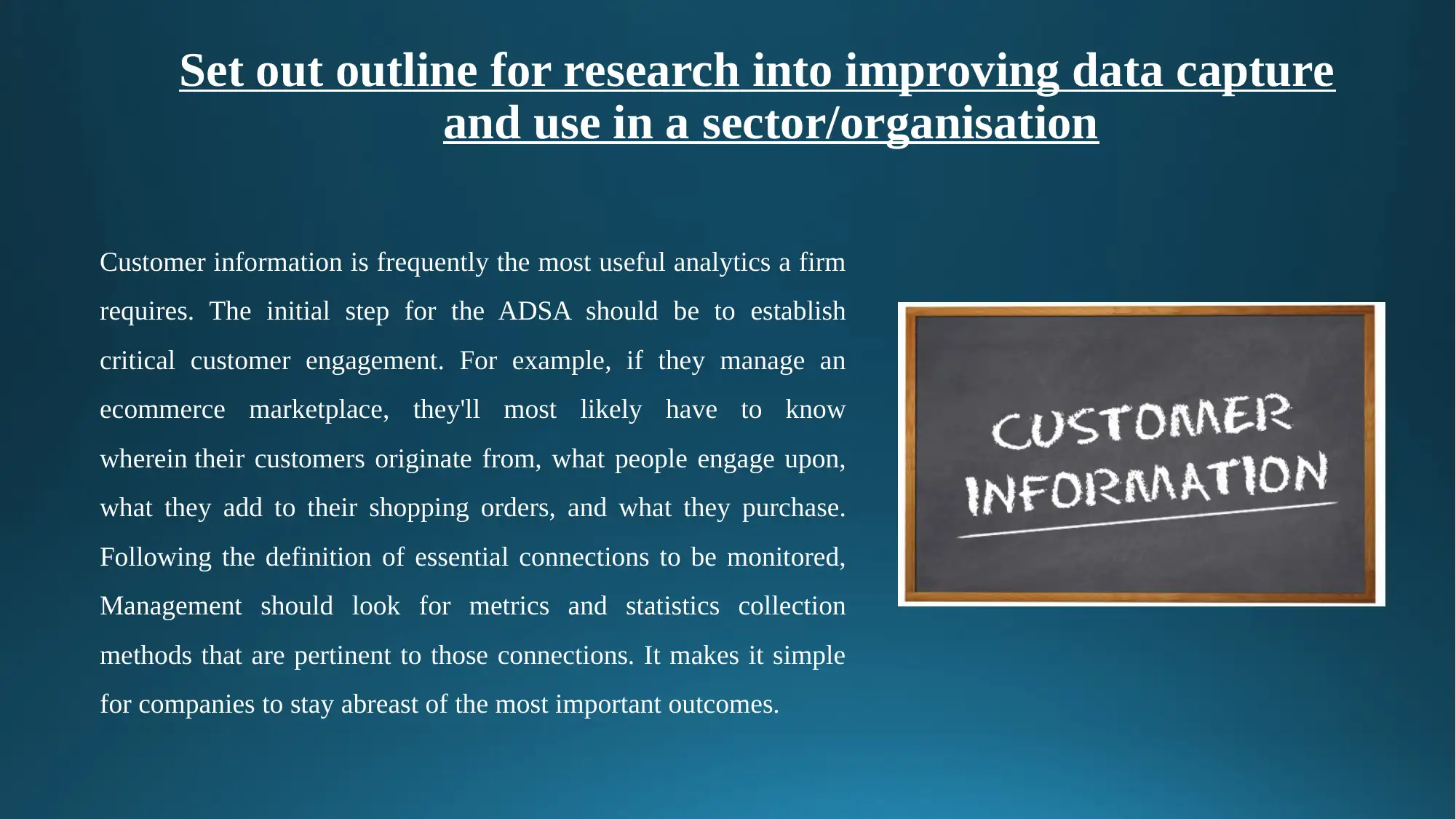
Set out outline for research into improving data capture
and use in a sector/organisation
Customer information is frequently the most useful analytics a firm
requires. The initial step for the ADSA should be to establish
critical customer engagement. For example, if they manage an
ecommerce marketplace, they'll most likely have to know
wherein their customers originate from, what people engage upon,
what they add to their shopping orders, and what they purchase.
Following the definition of essential connections to be monitored,
Management should look for metrics and statistics collection
methods that are pertinent to those connections. It makes it simple
for companies to stay abreast of the most important outcomes.
and use in a sector/organisation
Customer information is frequently the most useful analytics a firm
requires. The initial step for the ADSA should be to establish
critical customer engagement. For example, if they manage an
ecommerce marketplace, they'll most likely have to know
wherein their customers originate from, what people engage upon,
what they add to their shopping orders, and what they purchase.
Following the definition of essential connections to be monitored,
Management should look for metrics and statistics collection
methods that are pertinent to those connections. It makes it simple
for companies to stay abreast of the most important outcomes.
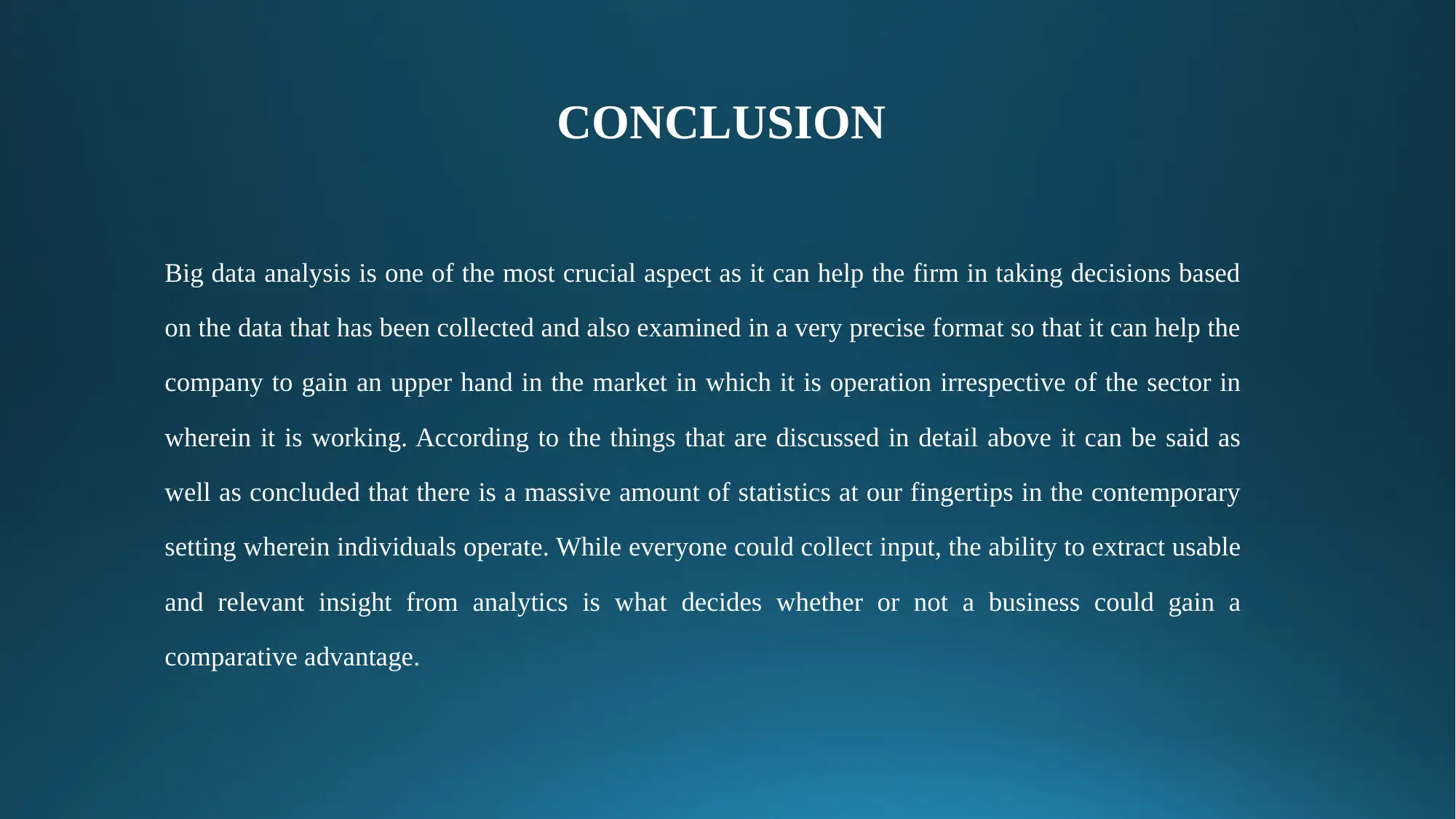
CONCLUSION
Big data analysis is one of the most crucial aspect as it can help the firm in taking decisions based
on the data that has been collected and also examined in a very precise format so that it can help the
company to gain an upper hand in the market in which it is operation irrespective of the sector in
wherein it is working. According to the things that are discussed in detail above it can be said as
well as concluded that there is a massive amount of statistics at our fingertips in the contemporary
setting wherein individuals operate. While everyone could collect input, the ability to extract usable
and relevant insight from analytics is what decides whether or not a business could gain a
comparative advantage.
Big data analysis is one of the most crucial aspect as it can help the firm in taking decisions based
on the data that has been collected and also examined in a very precise format so that it can help the
company to gain an upper hand in the market in which it is operation irrespective of the sector in
wherein it is working. According to the things that are discussed in detail above it can be said as
well as concluded that there is a massive amount of statistics at our fingertips in the contemporary
setting wherein individuals operate. While everyone could collect input, the ability to extract usable
and relevant insight from analytics is what decides whether or not a business could gain a
comparative advantage.
⊘ This is a preview!⊘
Do you want full access?
Subscribe today to unlock all pages.

Trusted by 1+ million students worldwide

References
• Al-Qirim, N., Tarhini, A. and Rouibah, K., 2017, August. Determinants of big data adoption and success. In
Proceedings of the International Conference on Algorithms, Computing and Systems (pp. 88-92).
• Chiu, Y.C., Lin, H.H. and Jou, Y.T., 2019, May. A Model Selection Method for Machine Learning by Differential
Evolution. In Proceedings of the 2019 4th International Conference on Big Data and Computing (pp. 135-139).
• Efendioğlu, D. and Bulkan, S., 2017. Capacity management in hotel industry for turkey. In Handbook of Research
on Holistic Optimization Techniques in the Hospitality, Tourism, and Travel Industry (pp. 286-304). IGI Global.
• Mukhibad, H., Kiswanto and Jayanto, P. Y., 2017. An analysis on financial and social performance of Islamic banks
in Indonesia. International Journal of Monetary Economics and Finance. 10(3-4). pp.295-308.
• Al-Qirim, N., Tarhini, A. and Rouibah, K., 2017, August. Determinants of big data adoption and success. In
Proceedings of the International Conference on Algorithms, Computing and Systems (pp. 88-92).
• Chiu, Y.C., Lin, H.H. and Jou, Y.T., 2019, May. A Model Selection Method for Machine Learning by Differential
Evolution. In Proceedings of the 2019 4th International Conference on Big Data and Computing (pp. 135-139).
• Efendioğlu, D. and Bulkan, S., 2017. Capacity management in hotel industry for turkey. In Handbook of Research
on Holistic Optimization Techniques in the Hospitality, Tourism, and Travel Industry (pp. 286-304). IGI Global.
• Mukhibad, H., Kiswanto and Jayanto, P. Y., 2017. An analysis on financial and social performance of Islamic banks
in Indonesia. International Journal of Monetary Economics and Finance. 10(3-4). pp.295-308.
Paraphrase This Document
Need a fresh take? Get an instant paraphrase of this document with our AI Paraphraser

Thank you
1 out of 11
Related Documents
Your All-in-One AI-Powered Toolkit for Academic Success.
+13062052269
info@desklib.com
Available 24*7 on WhatsApp / Email
![[object Object]](/_next/static/media/star-bottom.7253800d.svg)
Unlock your academic potential
Copyright © 2020–2025 A2Z Services. All Rights Reserved. Developed and managed by ZUCOL.


